Spectral Morphing in HISE
-
@clevername27 hello professor! sorry for the delay. And for my lack of preparation!
I want to achieve this kind of morph https://www.cerlsoundgroup.org/Kelly/sounds/trumpetcry.wavI actually want to start trying to use amplitudes from one audio with freqs from the other one to see what happens.
I can see Loris already prepares freqs and amps for morphing when I dolorisManager.createEnvelopePaths(file, "frequency", 1);Interface: distilling 24314 Partials Interface: sifting 24314 Partials Interface: collating 24330 Partials Interface: distilling 24266 Partials Interface: sifting 24266 Partials Interface: collating 24276 Partials Interface: channelizing 24330 Partials Interface: channelizing 24276 Partials Interface: Prepare partial list for morphingAnd this is how it's made on C++ but can replicate on HISE.
Going the FFT way is much harder for my level I guess.#include "loris.h" #include <stdio.h> #include <stdlib.h> #include <strings.h> int main( void ) { #define BUFSZ (3*44100) double samples[ BUFSZ ]; /* clarinet is about 3 seconds */ unsigned int N = 0; PartialList * clar = createPartialList(); PartialList * flut = createPartialList(); LinearEnvelope * reference = 0; LinearEnvelope * pitchenv = createLinearEnvelope(); LinearEnvelope * morphenv = createLinearEnvelope(); PartialList * mrph = createPartialList(); double flute_times[] = {0.4, 1.}; double clar_times[] = {0.2, 1.}; double tgt_times[] = {0.3, 1.2}; /* import the raw clarinet partials */ printf( "importing clarinet partials\n" ); importSdif( "clarinet.sdif", clar ); /* channelize and distill */ printf( "distilling\n" ); reference = createF0Estimate( clar, 350, 450, 0.01 ); channelize( clar, reference, 1 ); distill( clar ); destroyLinearEnvelope( reference ); reference = 0; /* shift pitch of clarinet partials */ printf( "shifting pitch of clarinet partials down by 600 cents\n" ); linearEnvelope_insertBreakpoint( pitchenv, 0, -600 ); shiftPitch( clar, pitchenv ); destroyLinearEnvelope( pitchenv ); pitchenv = 0; /* import the raw flute partials */ printf( "importing flute partials\n" ); importSdif( "flute.sdif", flut ); /* channelize and distill */ printf( "distilling\n" ); reference = createF0Estimate( flut, 250, 320, 0.01 ); channelize( flut, reference, 1 ); distill( flut ); destroyLinearEnvelope( reference ); reference = 0; /* align onsets */ printf( "dilating sounds to align onsets\n" ); dilate( clar, clar_times, tgt_times, 2 ); dilate( flut, flute_times, tgt_times, 2 ); /* perform morph */ printf( "morphing clarinet with flute\n" ); linearEnvelope_insertBreakpoint( morphenv, 0.6, 0 ); linearEnvelope_insertBreakpoint( morphenv, 2, 1 ); morph( clar, flut, morphenv, morphenv, morphenv, mrph ); /* synthesize and export samples */ printf( "synthesizing %lu morphed partials\n", partialList_size( mrph ) ); N = synthesize( mrph, samples, BUFSZ, 44100 ); exportAiff( "morph.aiff", samples, N, 44100, 16 ); /* cleanup */ destroyPartialList( mrph ); destroyPartialList( clar ); destroyPartialList( flut ); destroyLinearEnvelope( morphenv ); printf( "Done, bye.\n\n" ); return 0; } -
@hisefilo Sure, I will try to help you out here. Off the bat, I'm not too familiar with Loris, other it sounds like a Dr. a Doctor Seuss character. Looking at your code, it looks a lot like C, and that's a good thing.
A Choice of Language
Loris is a C++ library, but you can access using C, and I suggest you do this.
The thing about C is that everything you see usually has one meaning, and that meaning is not contextual. In contrast, there's C++, where the same snippet of code can do 100 different things. So C++ is great to program in, and terrible if you're trying to understand what some other developer has wrought. (Although not as bad as LISP, a language entirely designed for computer science students to write recursive decent parsers with.)
The other thing about C++ is what I call Bill's Law: C++ is sufficiently that no one person knows everything it does. The inverse is also true: it's possible to write C++ that is remarkably clear in its form and function. But if you're a C++ programmer who does this, then sadly, you don't exist.
So why does C code (generally) only do one thing? To make writing a C compiler easier. Specifically, so it can be easily translated to assembler language. Back when C was designed, processors were slow, and memory was capricious; so if you wanted things to run quickly (i.e., be compiled) you needed to do it quickly and efficiently. (Everybody has a great idea for a computer language until they need to write the compiler for it.)
OK, so why is this relevant for morphing sound? Because even if you're brand new to procedural programming, because writing C, and understanding C, are easier than working in C++. And because I’m trying to hide the fact that I know little about Loris, so I’m talking about things I might know.
A First Look at the Code
So, let's take a look at this code. I’m a little unclear how it morphs sound. For starters, I don’t see anything about the window size or window function. I’m looking for something like:
analyzer_configure( resolution, width );Wait, What Exactly is Morphing?
But let’s take a step back. How does morphing work?
One way to represent sound is as many, many sine waves. Depending on how loud each one of them is (and how that volume changes over time), you get either a piano or the sound of Bill Evans cursing because he can't get his code to compile.
So, you can:
- Decompose a sound into a set of partials.
- Then, a miracle occurs.
- Put the altered partials back together.
In Loris terminology, they call this additive synthesis. But I think that’s being charitable—to me, additive synthesis means literally using sine waves. And if the folks at Loris have figured out how to decompose sounds into perfect sine waves, then they folks working on quantum mechanics will want to have a word with them.
In your code example, partials look to be contextualised FFT bins. In that case, each partial actually represents many, many partials. Usually. Because the interesting thing about a flute is that you can represent it with a small number of partials. And that's why computer science students hate flutes…because by the end of their degree, they've re-synthesised them a hundred times.
Clarinets, on the other hand, are pure evil. (Have you ever met someone who plays them?)
Representing Sound as FFT Partials
So, the first thing we want to do, if we’re morphing sound, is to specify how we’re going to represent it. FFTs (or DFTs, to be technical about it) are a remarkably imprecise way to describe sound. The advantage is that you get a lot of information about amplitude and frequency.
One of the downsides is that the more precision you get with one (frequency or time), the less you get with the other. Plus, each FFT bucket has a splash zone (“smearing”) that leaks into the other buckets. Honestly. it’s amazing you can put it all back together and get the exact same sound.
So that will morph sound. But the results probably won’t sound very good.
Loris to the Rescue
And that’s where Loris shines, because its algorithms are constructed and tuned specifically for sound morphing. So, instead of using (say) a Blackman Harris windowing function, they use Kaiser–Bessel. What is a windowing function? In Loris, you don’t need to know (since there’s only one), so we don’t need to cover that.
Loris also determines many of the necessary parameters automatically, such as dealing with uneven frequency representation across the spectrum.
That still leaves a bunch of parameters you do need to specify, and some are specifically related to getting pleasant-sounding morphs.
The most important (arguably) specifies how our sounds will be represented. In Loris, they call this the Analysis parameters. But everyone else calls them the FFT parameters.
Frequency Resolution
Let’s look at the first parameter: Frequency Resolution. Imagine chopping up a sound into equally-sized chunks of sound.
To do that, let’s take a Kaiser windowed FFT of a flute. We’ll use SpectraLayers, because I get a royalty check. Above, we see a familiar representation using only amplitude information. Below, is a DFT-derived representation.
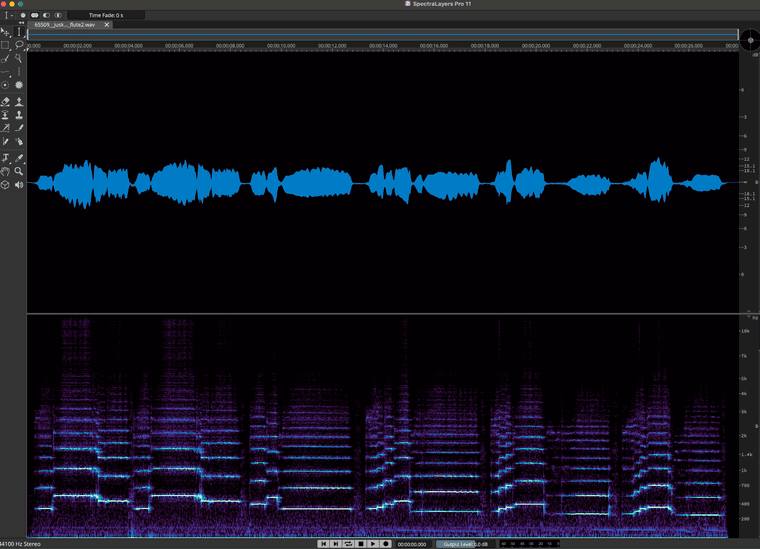
Each of those bars represents a partial. A partial represents a single sine wave. In most DFT-derived visualisations, each of these lines actually represents many partials. But with flutes, it's much closer to a 1-to-1 representation. (An additional reason for the clarity of the FFT is that SpectraLayer's creator, Robin Lobel, is very clever. He's using several high-speed optimisation techniques.)
Let's enlarge the FFT.
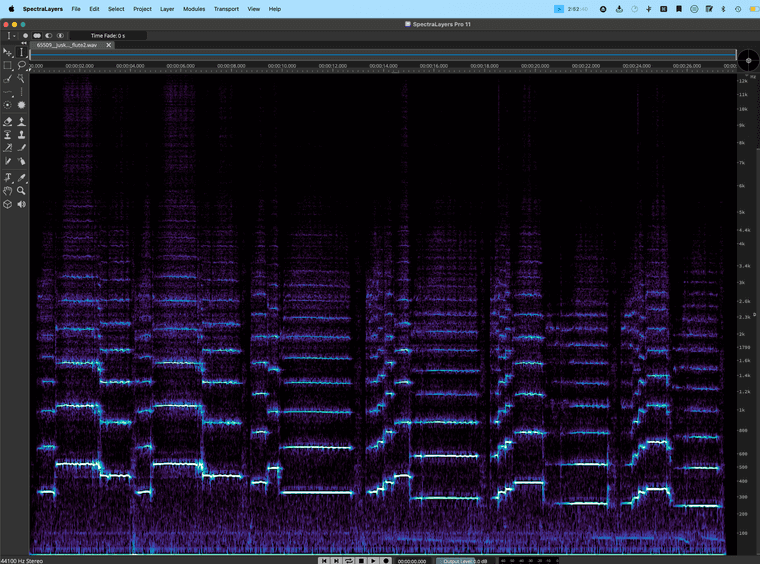
On the rights, you can see what frequencies are represented by the partials on the left. Amplitude is represented by colour, with white being the loudest. And time goes from left to right.
Now, let's look at that in 3D, so the height of a partial represents its amplitude.
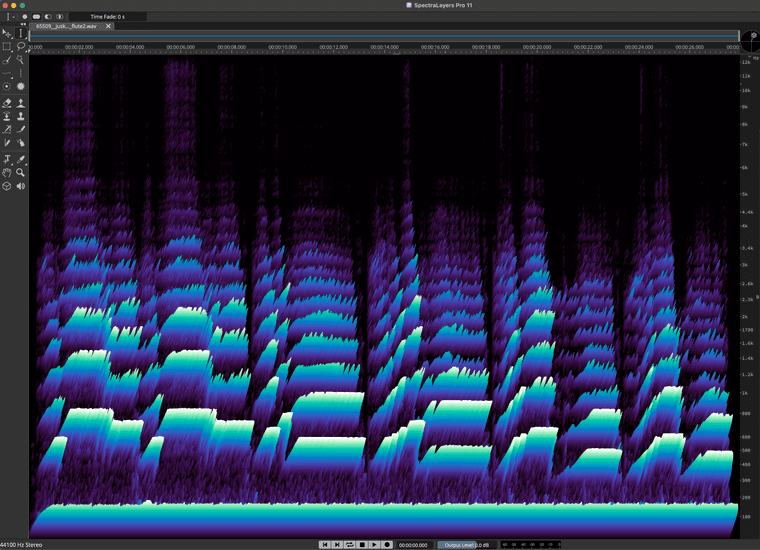
Let's restrict the colour spectrum of our flute to green:
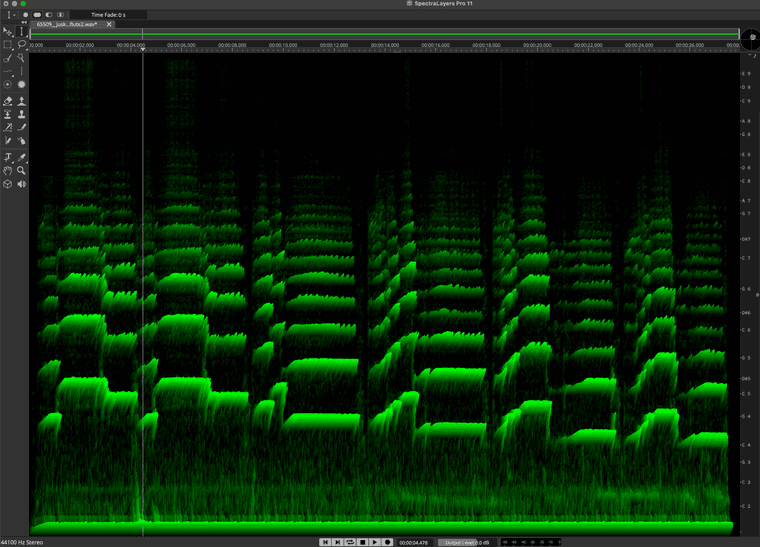
Let's look at a shorter time span of this recording:
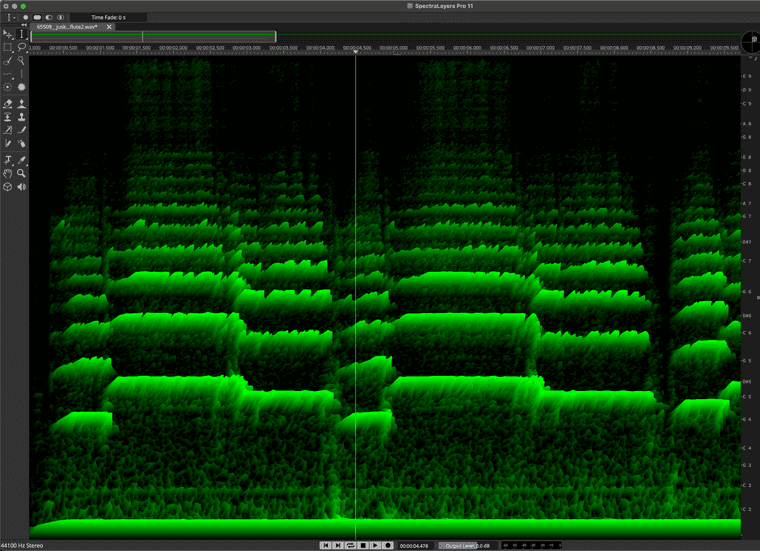
Now let's look at a clarinet and use orange to represent it:
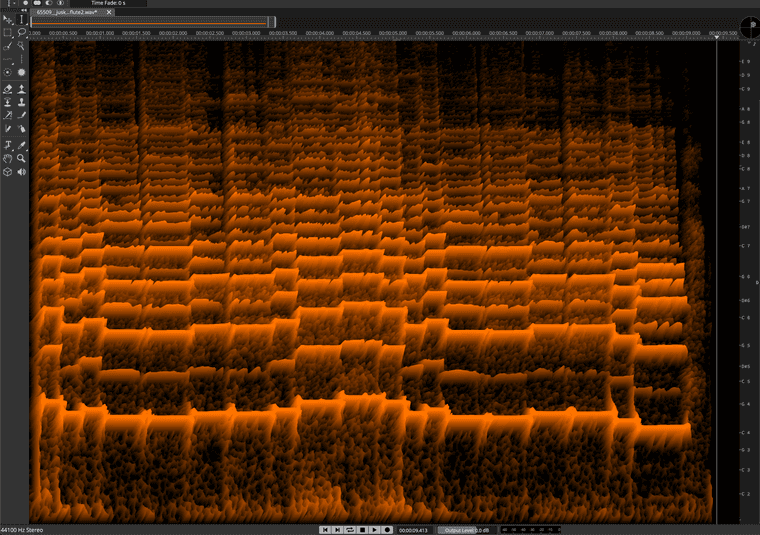
Notice the clarinet is comprised of many more partials.
Now, I'll make a quick demonstration of a crossfade between the two. With audio!
That doesn't sound cool. All of the partials are changing volume at the same rate. Boo!
Changing the FFT Bin Size
Wait, what's a bin? When we deconstruct a sound using an FFT, you end up with a grid of sounds. In Loris terminology, they're partials. Which are definitely not. We'll call them Bins.
Depending on the dimensions of the bins, we get either more frequency resolution, or more amplitude resolution. Or, to put it another way, the number of bins that you use, for dividing up the spectrum, designates the frequency resolution.
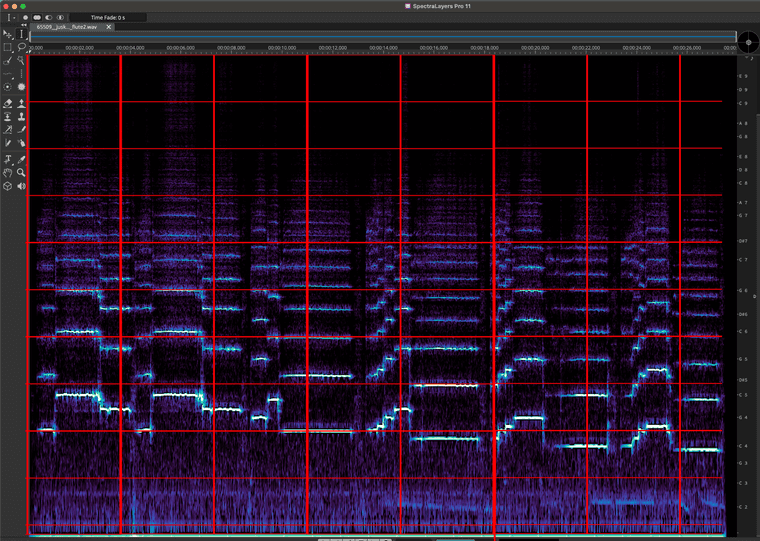
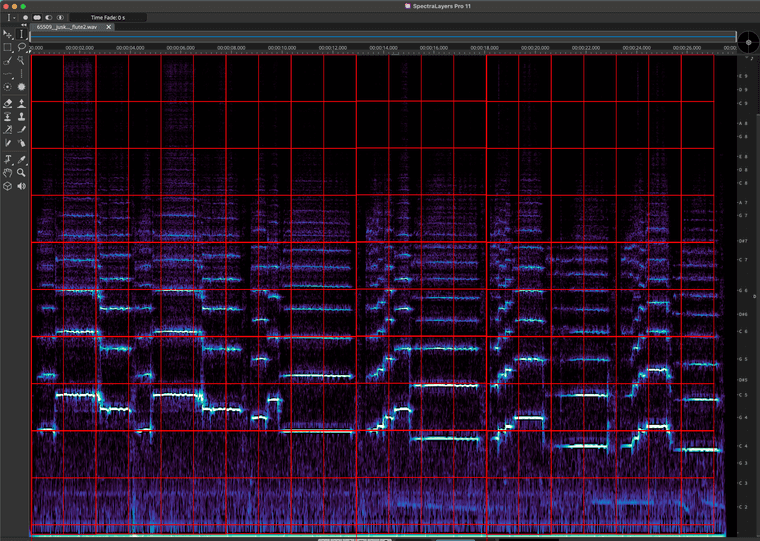
Let's change that in real-time:
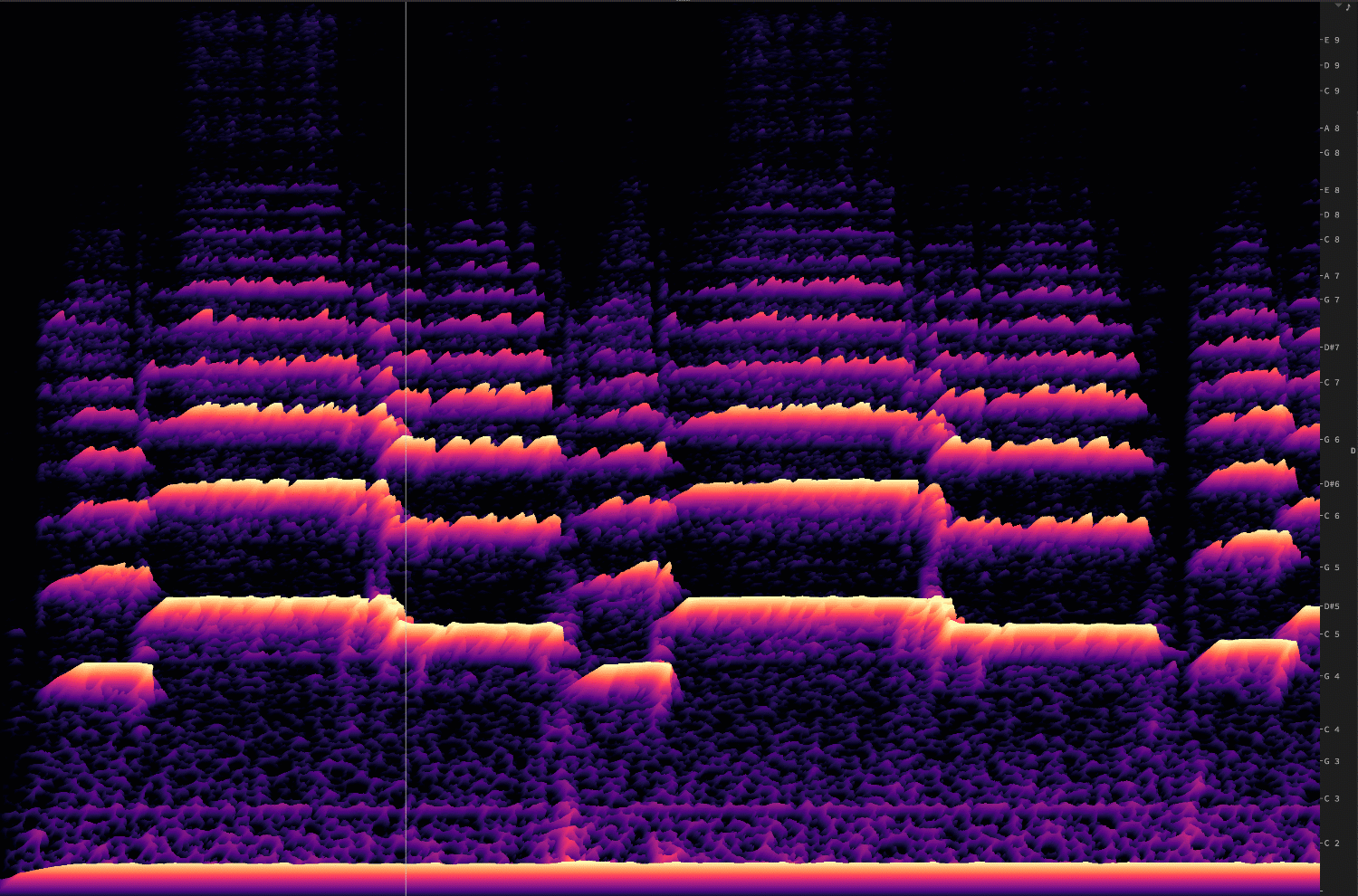
You can see how—as the frequency resolution goes down, the time resolution goes up.
Back to Loris
Now we know something about FFT analysis parameters. And that takes us back to:
analyzer_configure( resolution, width );I'm going to stop here for now.
-
-
Loris is additive. And it is possible to decompose sounds into sines. I did a crude job over the weekend. You use multiresolution FFT and then try and work out where the transients would have been using FFT reassignment. And then you increase the contrast of the spectrogram and track partials pitch, phase and amplitude over time, storing them in an array. You can then manipulate the partials in this array, and reconstruct the signal afterwards. The special thing that Loris does is that it can also analyse the noise components in a signal, which is beyond what my program can do.
I'm tempted to give in and just use Loris...
-
@griffinboy That sounds really cool, and I'd to follow your progress. Regarding sine waves—we may be taking about two different things here. Deconstructing sound into perfect sine waves, is not something that I believe is possible with our current understandings of physics and mathematics. You can certainly decompose sound into things that act like sine waves, though. I like that Loris has so many optimisations built right into it.
-
@griffinboy have you done that on HISE? or python Loris?
-
Maybe I'll post about it.
Ah yes - you are correct. You can't simply break a sound into it's actual sine waves perfectly (although reading some of the latest research on fft, there are some algorithms that are so good at it that it almost doesn't matter, not that I've implemented those yet). It's more a case of applying multiple passes of different FFT techniques to construct a map of everything, and then try and rebuilt something close. But unless you do a ton of passes and maybe use the most complicated fft research, there will be information lost and resolution issues -
Yeah it's c++ hise.
I mean, we have loris which is kind of better from the looks of it. Unless I decide to implement the latest research mine will not be better. But I can't say I care about additive to that extent. Maybe in the future I'll have a better reason to do all that work
-
@clevername27 WOW!!!!!!!!!!! What a lesson. Love it. Will take the time it deserves! Thanks, mate. You are passionate!
-
@griffinboy AFAIK, Loris does a cool job with noise-bandwidth, making many improvements to the good old residual noise + sines.
Nice idea to use a C++ custom node instead of Loris HISE's API. Will try that!
Thanks mate!